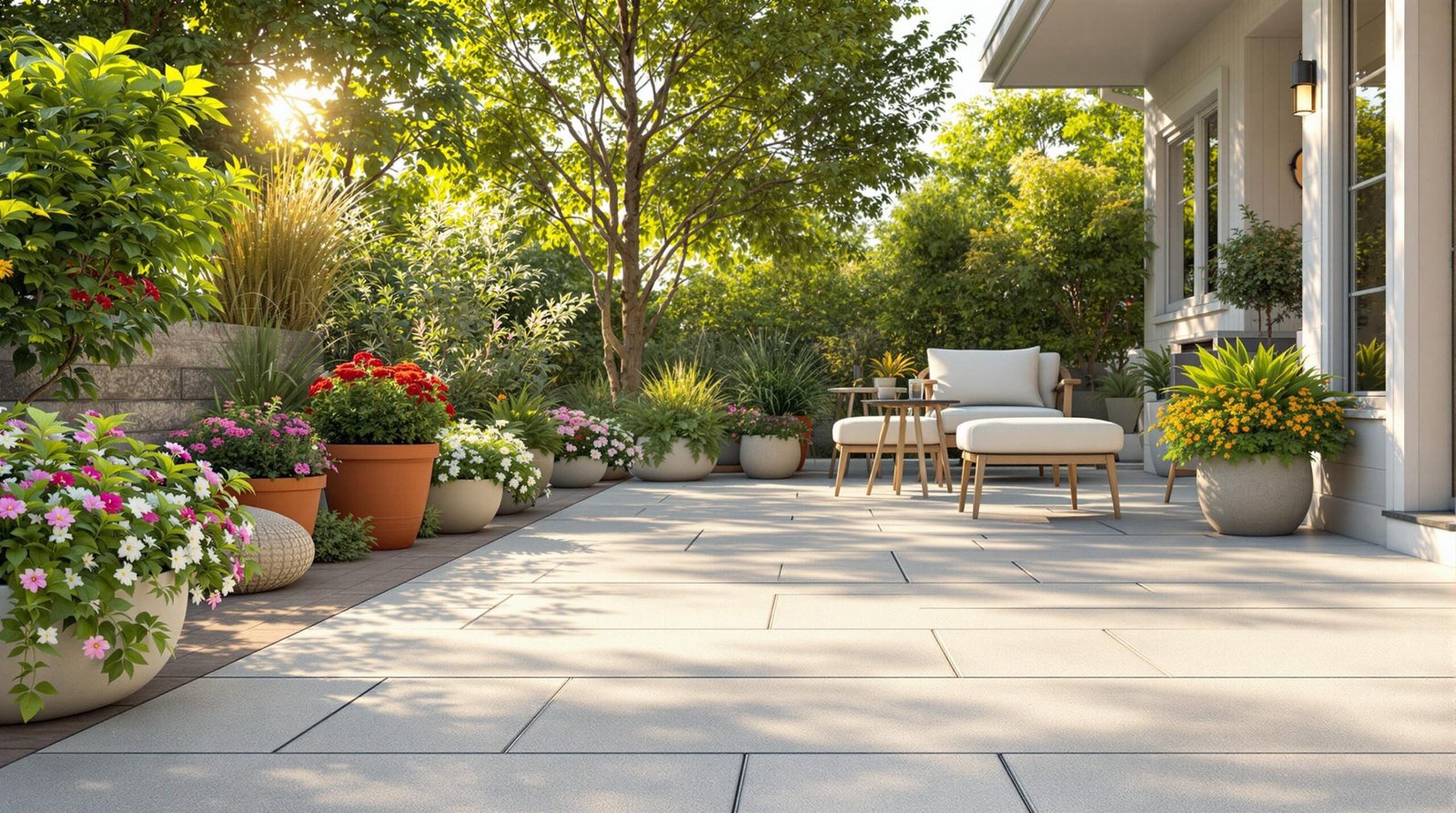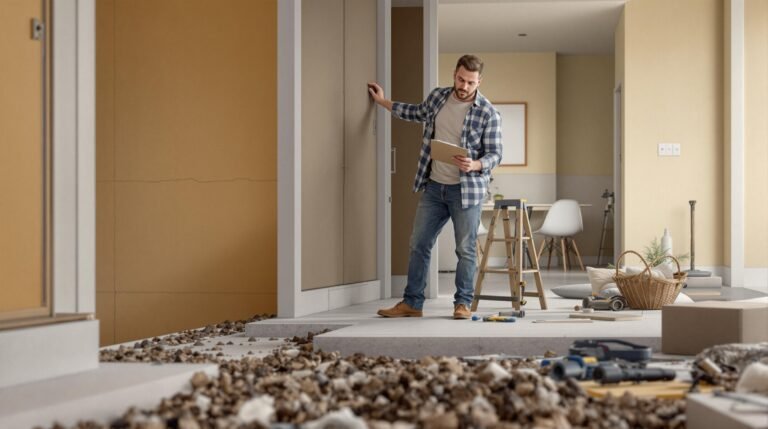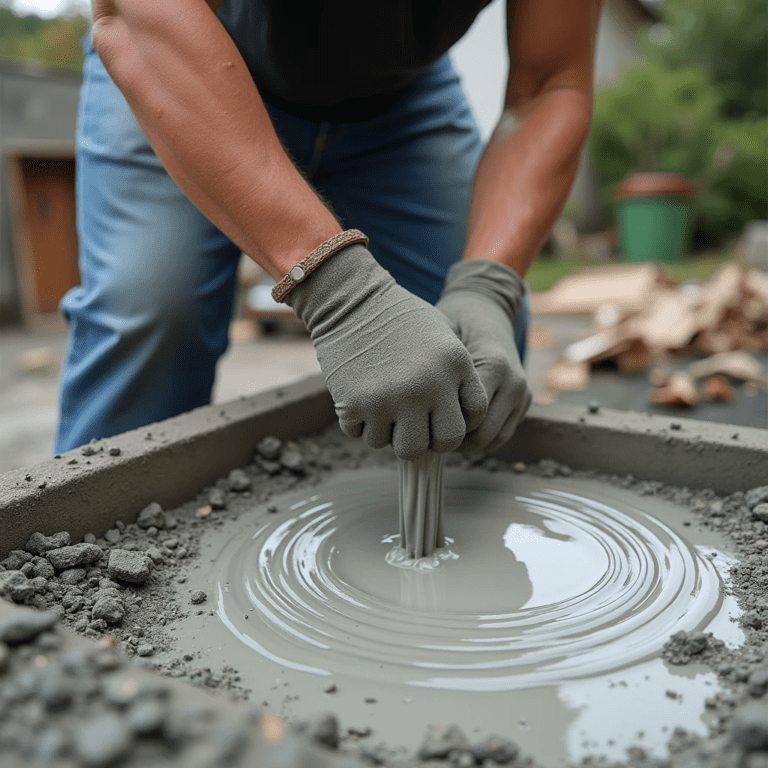24 Hours A Day 7 Days A Week

Maintaining a concrete patio is simple if you follow these key steps:
- Clean Regularly: Sweep debris, scrub with soapy water, and rinse thoroughly. Use a pressure washer for tough grime.
- Seal Every 2–3 Years: Protect against stains, weather, and UV damage with the right sealer (e.g., penetrating, acrylic, or polyurethane).
- Fix Cracks Early: Use polymer-based fillers and repair discoloration with tinted sealers or stains.
- Seasonal Care:
- Spring/Summer: Deep clean, check drainage, and reseal.
- Fall: Remove leaves, repair cracks, and clean thoroughly.
- Winter: Use safe ice melt, shovel gently, and avoid damaging tools.
Quick Tip: Watch for signs like fading color, stubborn stains, or spreading cracks to know when your patio needs maintenance.
A well-maintained patio can last over 30 years. Regular cleaning, sealing, and seasonal care will keep it durable and looking great.
How To Clean & Seal Your Concrete Patio
How to Clean Your Concrete Patio
Keeping your patio clean not only makes it look great but also helps it last longer.
Daily Cleaning Steps
To maintain a clean patio, sweep it regularly and scrub with warm, soapy water. Mix dish soap with warm water, then use a sturdy push broom to scrub the surface. Rinse thoroughly with a garden hose set to high pressure. For tougher grime, pressure washing can be a good option.
Pressure Washing Tips
- Start by applying a degreaser to loosen dirt and stains.
- Work from the highest point of the patio so water flows downward naturally.
- Keep the nozzle about 12 inches from the surface and use steady, sweeping motions.
Always wear protective gear, test the pressure washer on a small, hidden area first, and never aim the nozzle at people or pets.
Tough Stain Removal
If daily cleaning doesn’t cut it, you’ll need to tackle stains with specific methods.
Oil and Grease Stains
- Cover fresh spills with cat litter, sawdust, or cornstarch to absorb the oil.
- Make a paste with baking soda and water, apply it to the stain, and let it sit for 30–60 minutes.
- For stubborn stains, use a commercial concrete degreaser.
Rust and Mineral Deposits
- Pour white vinegar directly onto rust stains and let it sit for about an hour.
- Scrub the area with a stiff-bristle brush.
- Use a cleaner containing oxalic acid for stains that don’t budge.
Mildew Treatment
- Mix one part chlorine bleach with two parts water.
- Apply the solution to the mildew and let it sit for 5–30 minutes.
- Scrub with a nylon-bristled brush and rinse thoroughly with water.
Sealing Your Patio
Why Seal Your Concrete Patio?
Sealing your concrete patio is a smart way to protect it and extend its lifespan. A sealed patio can last over 30 years, while an unprotected one might not even make it to 20 years. The sealer acts as a shield, protecting against:
- Weather Damage: Blocks moisture and prevents surface cracking.
- Stains: Keeps grease, oil, and chemicals from leaving permanent marks.
- UV Rays: Helps maintain color and prevents fading.
- Mold and Moss: Reduces growth by keeping moisture out.
Choosing the right type of sealer is key to getting these benefits.
Comparing Concrete Sealers
Here’s a quick breakdown of common sealer options for residential patios:
| Sealer Type | Best For | Appearance |
|---|---|---|
| Penetrating | High-traffic areas with a natural look | Invisible, matte finish |
| Acrylic (water-based) | Adding color and UV protection | Low-gloss satin |
| Acrylic (solvent-based) | Deepening color and stain resistance | High-gloss wet look |
| Polyurethane | Strong chemical resistance | Clear to high-gloss |
"A good concrete patio sealer keeps new surfaces looking great for many years to come and improves the appearance of existing patios, especially if they are topically colored." – Anne Balogh, ConcreteNetwork.com
Once you’ve picked the right sealer, applying it correctly is just as important.
How to Apply Concrete Sealer
-
Prep the Surface
Clean the patio thoroughly, repairing any cracks or damage. Make sure the surface is completely dry before sealing. For new concrete, wait at least 28 days before applying a sealer. -
Check the Weather
Apply the sealer when temperatures are between 45°F and 85°F (7.3°C to 29.5°C). Avoid sealing if rain is expected within 24 hours. -
Apply the Sealer
Use a paint roller for water-based sealers and a pump sprayer for solvent-based ones. Apply thin, even coats, covering 250–300 square feet per gallon. For better coverage, apply a second coat in the opposite direction.
Pro Tips for Best Results
- Avoid overapplying to prevent bubbles or uneven coverage.
- Add anti-skid additives to high-gloss sealers for better safety.
- Let each coat dry completely before applying the next or allowing foot traffic.
- Reseal every 3–5 years to keep your patio protected.
Taking these steps ensures your patio stays in top shape for years to come.
sbb-itb-2aa6074
Fixing Common Patio Problems
Repairing Small Cracks
For cracks up to 1/2-inch wide and 1/4-inch deep, a polymer-based filler works well. Start by cleaning the crack with a wire brush and vacuum. Use a masonry chisel to widen the crack into a V-shape – this helps the filler adhere better. If the crack is deeper than 1/4-inch, add sand or a backer rod before applying the filler. Use a caulking gun to apply the polymer-based filler when the temperature is between 50°F and 90°F. Smooth it out with a putty knife and let it cure for 24 hours.
Fixing Color Issues
Once cracks are sealed, you can tackle discoloration to bring your patio back to life:
- Use tinted sealers with a roller or sprayer to refresh the color.
- Apply penetrating stains with a brush or spray for a natural, blended look.
- Roll or trowel on cementitious coatings for a full color makeover.
"Tinted sealers are an excellent solution for contractors and DIY enthusiasts looking to enhance or modify concrete color without breaking the bank… The key is proper application and selecting the right product for your specific needs."
Before applying any coloring product, clean the surface thoroughly and test the color in a small, hidden area first.
Removing White Mineral Deposits
Efflorescence, those white mineral deposits on concrete, happens when water-soluble salts rise to the surface. While it’s mostly a cosmetic issue, it may point to moisture problems. Here’s how to deal with it:
-
For light deposits:
- Scrub with a stiff brush.
- Use pressurized water if needed.
- Let the surface dry completely.
-
For tougher deposits:
- Wet the surface with clean water.
- Apply an efflorescence remover or a weak acid solution.
- Neutralize the area with a baking soda solution (1 pound per 5 gallons of water).
- Rinse thoroughly.
"Efflorescence is a fact of life with most concrete… It is an aesthetic issue, an issue we would all like to avoid."
After cleaning, apply a water repellent or acrylic coating to help prevent it from coming back. Before sealing, test the surface pH to ensure no residual acid remains.
Patio Care by Season
Spring and Summer Care
When the temperature rises above 50°F, it’s time to inspect your patio. Use a mild detergent and a pressure washer set between 2,000–3,000 PSI to clean off winter grime and salt residue.
- Adjust gutters and downspouts to direct water away from the patio.
- Fill any new cracks with high-quality, flexible concrete caulk.
- Apply a sealer on a dry, overcast day to avoid quick evaporation.
During the summer, protect your patio from heat and UV rays. Place protective pads under furniture to prevent scratches and allow airflow. Clean up spills immediately to avoid stains, as heat can make them harder to remove.
As summer ends, shift your attention to preparing for fall maintenance.
Fall Maintenance Steps
- Remove leaves weekly to prevent moisture buildup and staining.
- Clean the surface thoroughly with a gentle pressure washer (set below 3,000 PSI).
- Repair cracks or surface spalling before the temperatures drop.
Store or cover patio furniture to avoid rust and water damage. Clear nearby gutters and ensure the soil is graded to direct water away from the patio for proper drainage.
Winter Protection Methods
Keep your patio safe during winter with these tips:
Safe Ice Management:
- Opt for ice melt products made with calcium chloride or magnesium chloride.
- Avoid using products containing ammonium nitrates or ammonium sulfates.
- Apply ice melt sparingly – just enough to ensure safety.
Use a plastic shovel with rounded edges for snow removal to avoid damaging the surface. Shovel early and often to prevent ice from forming. Avoid metal shovels or sharp tools that could harm the concrete.
"Sealing is arguably the best way to protect concrete slab surfaces, and doing this before temperatures drop will help prevent the moisture in ice and snow from soaking into the concrete surface and weakening it when it freezes." – Bob Vila
For extra traction on icy surfaces, spread clean sand or kitty litter instead of rock salt. These options provide grip without causing chemical damage to the concrete.
Required Tools and Products
Cleaning Equipment List
To get your patio cleaning done right, you’ll need these tools:
- A heavy-duty push broom or a leaf blower to clear debris
- A garden hose with an adjustable nozzle for rinsing
- A scrub brush with stiff bristles for tough spots
- A large sponge or mop for thorough cleaning
- Spray bottles or buckets to mix and apply cleaning solutions
- Protective tarps to shield nearby plants from chemicals
For hard-to-remove grime, check out the pressure washing tips mentioned earlier.
Once your cleaning gear is sorted, focus on selecting high-quality sealers and repair products to keep your patio in top shape.
Sealer and Repair Materials
Picking the right sealer and repair materials is key to extending the life of your patio. Here’s what you’ll need:
Sealers:
- Penetrating sealers (like silanes or siloxanes) designed for outdoor use
- UV-resistant, breathable sealers
- Sealers with anti-slip additives for better safety
For fixing cracks or surface flaws, stock up on these:
- Flexible concrete caulk
- Polymer-modified cement for overlays
- Color-matched repair compounds
- Concrete cleaner or degreaser
"Regular resealing with a concrete sealer is the most important thing that can be done to protect the surface finish from damage." – Endura Stamped Concrete
Don’t forget to use safety gear when handling these chemicals and tools.
Safety Gear Checklist
Stay safe by using the right gear for each task. Here’s a quick guide:
| Task Type | Required Safety Equipment |
|---|---|
| Cleaning Tasks | Waterproof gloves, safety glasses, long-sleeve shirt, full-length pants |
| Chemical Cleaning | Chemical-resistant gloves, full-coverage goggles, respirator, rubber boots |
| Pressure Washing | Heavy-duty raincoat, waterproof bib/pants, safety goggles, earplugs, rubber boots |
| Sealer Application | Chemical-resistant gloves, respirator, eye protection, long sleeves/pants |
When working with chemicals, wash frequently with pH-neutral soap and clean water. Also, make sure to use ear protection during pressure washing.
Conclusion: Long-Term Patio Care
Taking care of your patio over the years requires consistency. A well-maintained patio not only enhances your outdoor space but also helps retain its value.
The foundation of proper patio care is regular cleaning and preventive maintenance. Stick to a cleaning schedule and reapply sealer when necessary. Combine these habits with the seasonal care tips we’ve discussed.
Here’s a helpful maintenance timeline:
| Timeframe | Maintenance Tasks |
|---|---|
| Weekly | Sweep debris and clean up spills quickly. |
| Monthly | Inspect for cracks and check drainage. |
| Bi-annually | Deep clean and evaluate the sealer. |
| Every 2–3 years | Reapply concrete sealer. |
Protect your patio from harsh weather by using saucers under potted plants to avoid stains, covering or storing furniture, and ensuring drainage is functioning properly. In icy conditions, opt for non-damaging traction methods instead of salt.
Regular power washing can help you spot early signs of trouble, while sealing protects against water damage, UV rays, and daily wear.
Watch for these warning signs that your patio needs attention:
- Water no longer beads on the surface.
- Stains are becoming harder to remove.
- The color looks dull or faded.
- Small cracks are forming.
- Moss or algae are spreading quickly.



